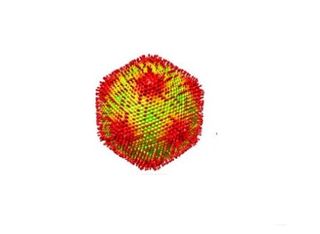Giant Newfound 'Medusa' Virus Turns Amoebas to 'Stone'

Like the mythical monster Medusa, a newfound giant virus turns its host to "stone." But, luckily for us, its hosts are amoebas.
Now called Medusavirus for its seemingly mythical powers, the strange virus was pulled from the muddy waters of a hot spring in Japan, according to a new study, published Feb. 6 in the Journal of Virology. Medusavirus belongs to a group known as "giant viruses," which have exceptionally large genomes compared with most other viruses.
The virus infects single-celled organisms known as Acanthamoeba castellanii, a type of amoeba. When the researchers infected these amoebas in lab dishes, they found that the virus prompted the amoebas to develop a thick outer "shell" and enter a dormant state known as encystment. (The amoeba can naturally enter this state in response to stress in its environment.) That behavior reminded the researchers of the mythological monster Medusa, who, according to Greek mythology, could turn onlookers to stone with her gaze. [Going Viral: 6 New Findings About Viruses]
While the virus doesn't sport a head full of writhing snakes, researchers found a just-as-amazing, unique feature on Medusavirus' outer surface: more than 2,600 spherical-headed spikes, according to the study, led by researchers at Kyoto University and Tokyo University of Science in Japan. The virus is different enough from other giant viruses that the researchers proposed that it should be classified in a new family: Medusaviridae.
Interestingly, a number of genes in Medusavirus were also found in its amoeba hosts. This suggest that Medusavirus has infected these amoebas since "ancient times" and that the two microorganisms have exchanged genes over the course of evolution, the researchers said.
"Medusavirus is a unique giant virus that still preserves the ancient footprints of the virus-host evolutionary interactions," the researchers said in a statement.
The scientists plan to continue to study Medusavirus with the hope of further unraveling the evolutionary history of viruses and cells.
Sign up for the Live Science daily newsletter now
Get the world’s most fascinating discoveries delivered straight to your inbox.
- Magnificent Microphotography: 50 Tiny Wonders
- 8 Awful Parasite Infections That Will Make Your Skin Crawl
- The 9 Deadliest Viruses on Earth
Originally published on Live Science.

Rachael is a Live Science contributor, and was a former channel editor and senior writer for Live Science between 2010 and 2022. She has a master's degree in journalism from New York University's Science, Health and Environmental Reporting Program. She also holds a B.S. in molecular biology and an M.S. in biology from the University of California, San Diego. Her work has appeared in Scienceline, The Washington Post and Scientific American.
Most Popular

